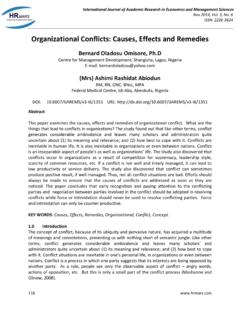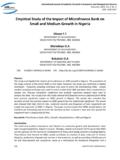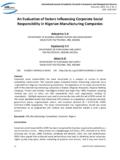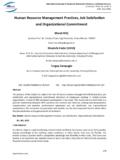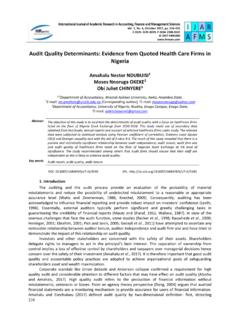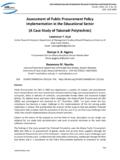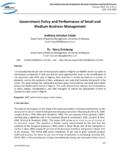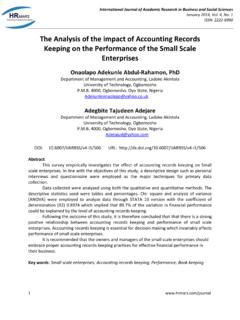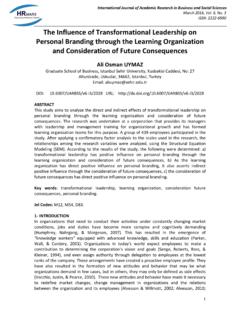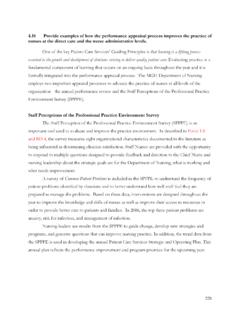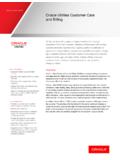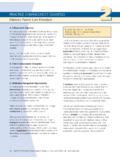Transcription of Impact of Enterprise Resource Planning System in …
1 International Journal of Academic Research in Business and Social Sciences December 2013, Vol. 3, No. 12 ISSN: 2222-6990 404 Impact of Enterprise Resource Planning System in Health Care Michael M Sanja PhD in Business information systems (Student) JOOUST University, Town Campus 1031, Kitale Kenya. E-mail: DOI: URL: Abstract ERP System in place offers healthcare the opportunity to attract world-class physicians, clinicians, and researchers by providing a very effective and efficient environment. This paper analyses the need for: migration from traditional health operation systems to electronic storage and reporting systems - a full operational electronic web based System as a source of data for Health care and a commitment to the use of health System information in evidence-based management decision making.
2 ERP System in place eliminates duplication and manual processes and proactively increases patient safety through the use of efficient and effective information systems. The aim of this paper is to offer an exploration of ERP in the delivery of healthcare in counties its diverse organizational and regulatory settings, since Counties are an important factor in the current Kenyan devolution economies .This model is applied in an empirical study of a project to introduce a ERP System in Trans Nzoia County health care in Kenya. Both qualitative and quantitative methods will be used to obtain a general understanding of ERP implementation in Health sector Key Words: Information Technologies (IT), County, HealthCare, ERP ( Enterprise Resource Planning ) INTRODUCTION Health care is characteristic distinction between activities directed at keeping people healthy and activities directed at restoring health once a disease or injury occurs.
3 Keeping people healthy is the domain of the public health care System and the activities associated with behavioral health. Health care involves activities that work at the population level to keep people healthy: protecting the environment, making sure water supplies and restaurants and food are safe, and providing preventive health services, for example. Behavioral health focuses on helping people make behavioral choices that improve or protect health: for example, not smoking, eating well, exercising, and reducing stress. ERP systems can also be an instrument for transforming functional organizations into process oriented ones.
4 When properly integrated, ERP supports process-oriented businesses effectively (Al-Mashari, 2003). It is argued that 65% of managers believe ERP project failure will damage a firm. The complexity of ERP, high costs and implementation problems force numerous organizations to reconsider their new plans in relation to this Enterprise System (Kumar and Hillegersberg, 2000). International Journal of Academic Research in Business and Social Sciences December 2013, Vol. 3, No. 12 ISSN: 2222-6990 405 Although ERP applications constitute well structured, reliable information technology (IT) backbones of fortune 500 companies worldwide (Hofmann,P, 2008).
5 ERP increases effective use in health services, reduces waiting time of patients at Emergency Department and service Work stations and provides better value for purchases at pharmacies by implementing ERP the organization improves the performance of existing business processes, reduces receivable days, credit returns and also improves the back end efficiency. The major suppliers of ERP systems, like SAP and Oracle, strategically consider health care, and especially hospitals, to be a new and growing market. Therefore, special applications, such as patient management, patient logistics, hospital finance and general management, have been developed so that the ERP System fits with the hospital setting.
6 There are a number of reasons why hospitals differ from other industries, and these may have implications for the implementation and use of an ERP in this setting. First, the objectives of hospitals are diverse, since they aim at curing and caring for patients, as well as training and educating new doctors and nurses. Given the diversity of the hospital workforce, the implementation and use of an ERP System requires the cooperation of a large spectrum of professionals, ranging from medical practitioners, such as doctors, nurses and laboratory assistants, to groups that provide non-medical services, such as hospital managers and IT departments.
7 Heeks (2006) suggested that in this context, three different rationalities may collide, namely technical, managerial and medical. Technical rationality is associated with IT professionals and IT suppliers, who share a technical worldview on which they base their System designs. Managerial rationality applies to hospital managers who operate from legal, financial and control perspective. In its basic definition, ERP is an Enterprise -wide information System that integrates and controls all the business processes in the entire organization. According to Nah and Lau (2001) ERP is a packaged business software System that enables a company to manage the efficient and effective use of resources (materials, human resources, finance, etc.)
8 By providing a total, integrated solution for the organization s information-processing needs . This software facilitates, if well-implemented, the integration of all the functional information flows across the organization into a single package with a common database. Therefore, it allows easy and immediate access t information regarding inventory, product or customer data, and prior history information (Shehab et al., 2004). Physicians need timely access to patient data and information stored in the hospital and clinical information systems. Efficient patient care delivery by physicians and clinicians is a necessity for healthcare organizations.
9 The study shows how the ERP implementation impacts data management, monitory, data retrieval and data storage which enables stakeholders such as physicians and administrators. ERP have a lot to ponder in terms of managing Medical services or healthcare monitory issues, management Impact , costs and in improving the quality of care (Kolodner et al. 2008). By implementing ERP we provide different ways to reduce patient waiting times, credit returns, International Journal of Academic Research in Business and Social Sciences December 2013, Vol. 3, No. 12 ISSN: 2222-6990 406 improve back-end efficiency.
10 This paper is based upon exploratory research analyzing the historical cases dealt with county hospitals and Pharmaceuticals, where the ERP played their significant role in enhancing their overall efficiency. In addition to the embedded role of ERP, in clinical and diagnostics equipment, ERP are uniquely positioned to capture, store, process, and communicate timely information to decision makers for better coordination of healthcare at both the individual and population levels. For example, data mining and decision support capabilities can identify potential adverse events for an individual patient while also contributing to the population s health by providing insights into the causes of disease complications.
